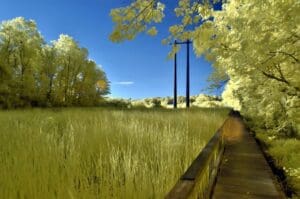There’s a hidden gem nestled within the Pocomoke River State Park, a place where time seems to slow down and the world outside fades away.
Compiled By Chris Murphy / Article Provided by dnr.maryland.gov/centennial/Pages/Centennial-Notes/SouthernExposure.aspx
Have you ever imagined what it’s like to paddle through a bald cypress swamp? The spring is a great time to plan a trip to Pocomoke River State Park in Worcester County to uncover the secrets of the Great Cypress Swamp. Travel just 20 minutes outside of Salisbury and three miles south of Snow Hill, and you will stumble upon Shad Landing where you can begin your journey to learn more about the history and inhabitants of this often-misunderstood ecosystem.
Mysterious and lush, mature stands of bald cypress draped with Spanish moss represent the primeval nature of the southern swamps. These forested wetlands are found in the southeastern Coastal Plain along streams, rivers, spring runs or ponds with still or slow moving water. The Great Cypress Swamp originates on the Maryland-Delaware border and flows southwest for 73 miles before emptying into Pocomoke Sound. It is the northernmost bald cypress swamp in the United States.
Bald cypress trees are deciduous trees with needle-like leaves. They can grow up to 120 feet tall and live up to 600 years. The trees are most easily recognized by their “knees” and buttressed trunks. It is believed the knees serve as an oxygen supply to the submerged root system and help protect the trees from high wind and unstable environments.
The Pocomoke River basin is an area rich in the history of the Delmarva Peninsula. Archaeological evidence indicates the river’s first inhabitants lived more than 10,000 years ago. Recorded site data shows the Pocomokes, Nanticokes, Nassawattox, and several other tribes of the Algonquin Nation, set up villages along its banks. By the late 1600s, these Native American communities were scattered as a result of encroaching European colonization. Nearly 300 years later, the U.S. Department of the Interior designated the Pocomoke as part of the Beach to Bay Indian Trail, a National Recreational Trail to identify and preserve the area’s cultural history.
In the growing economy of the late 1700s and early 1800s, the hardwood of the bald cypress was in high demand as it was discovered to be extremely resistant to rot and decay. Early settlers along the Pocomoke began logging the swamp, using the cypress wood for shipbuilding, shingles, siding on homes, water tanks and coffins. In addition, brick manufacturing, the smelting of iron from the swamp’s bog ore, and the shipping of tobacco and lumber flourished. Snow Hill and Pocomoke City soon developed as the principal towns along the river.
By the mid-1800s, the swamp had become an important link in the Underground Railroad; escaping slaves and their abolitionist guides followed the river into Delaware and eventually north to the safety and freedom of Pennsylvania. The swamp also attracted its share of miscreants: During the Civil War, deserting Union and Confederate troops, outlaws, bootleggers and smugglers, all found refuge in the inaccessible wilderness beneath the tall cypress trees.
After the war, as things returned to normal and technology improved, the swamp became more accessible to lumbermen and most of its trees were cut down. The Pocomoke River swamp forest had been completely timbered by the 1930s when the federal government began acquiring abandoned land in the watershed. The state assumed control of the land in the mid-1950s and with subsequent protection, the swamp has returned to a more natural state. The trees you’ll see along the Pocomoke River today are approximately 100 years old.
While exploring the cypress swamp at Pocomoke River State Park, visitors often ask why the water appears so dark. Pocomoke is a Native American word meaning “black water.” The tannic acid found in the cypress needles and the decaying leaves of trees and plants that line its banks, seep into the river creating the dark, brown color. Despite its appearance, the water is not dirty! To the contrary — it serves as a thriving habitat for fish, birds and mammals. As any number of anglers who set out in the early morning hours in search of largemouth bass, trout, perch and bluegills will attest. The cypress swamp also provides breeding sites for a variety of toads, frogs and salamanders.
Pocomoke River State Park has become a popular destination for birdwatchers from all over the country. Bald eagles, osprey and other birds of prey are often seen nesting in the top of the bald cypress trees. The common prothonotary warbler builds nests in the cavities of decaying cypress knees. The park becomes increasingly popular in late April as visitors flock to the Delmarva Peninsula to celebrate the migration of hundreds of warblers, waterfowl, nesting birds and raptors during Delmarva Birding Weekend.
The Pocomoke River is one of only nine rivers in the state of Maryland designated as a Wild and Scenic River. You can explore the swamp by boat, which you can rent at Shad Landing. And be sure to pick up a copy of Corker’s Creek Canoe Trail Guide- Life in a Bald Cypress Swamp. This self-guided interpretive map will take you on a 2-mile paddle through the swamp. Guided trips along the river with a park naturalist are also offered on weekends throughout the summer months.





















